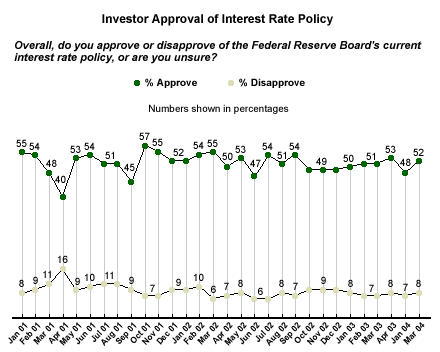The Federal Open Market Committee, in a monetary policy stance defined by low inflation and weak job growth, maintained its target federal fund rate at 1% when it met on March 16. It was widely anticipated among financial experts that policy would remain accommodative and the key rate would be held at its current level -- a 46-year low.
And while there seems to be no immediate catalyst for a rate hike, some Fed-watchers are becoming increasingly critical of the Federal Reserve's policy of patience. In a speech defending Fed policy last week, Federal Board Governor Donald Kohn noted that some observers are "concerned that continued policy accommodation is distorting interest rates and asset prices and encouraging a build-up of debt, and thereby laying the groundwork for financial and economic instability."
Economists may have their differences with the Fed, but what does the average American investor think? The latest UBS/Gallup Investor Optimism survey* (conducted in early March, before the FOMC meeting) polled investors on their perceptions of the Fed's monetary policy and their outlook for interest rates.
Federal Reserve Board Approval Ratings
Since 2001, Gallup has been asking investors whether they approve or disapprove of "the Federal Reserve Board's current interest rate policy." Approval reached a low of 40% in April 2001 as the economy entered into recession, and rebounded to a high of 57% in October 2001, a month before the recession officially ended. The percentage of investors who are in favor of Federal Reserve policy has since stabilized at around 50%, rising slightly from 48% in January 2004 to 52% in March.
However, a large number of respondents -- 40% -- expressed no opinion on the subject, as did 45% of investors participating in the January survey. In fact, a large percentage of investors surveyed by Gallup consistently report that they are "unsure" or "don't know" if they approve or disapprove of the Federal Reserve's current interest rate policy.

Investors with larger portfolios have tended to be more approving of Fed policy than their less affluent counterparts are. Gallup defines "substantial" investors as those with more than $100,000 in investable assets, while those with assets in the range of $10,000 to $100,000 are considered "average" investors. In March last year, 62% of substantial investors were more approving, compared with 44% of their average counterparts. In January 2004, 54% of substantial investors and 44% of average investors approved of Fed policy. However, in the most recent survey, the two groups differed little in their assessments of Fed interest rate policy: 55% of substantial investors approved, compared with 51% of average investors.

Outlook for Fed Fund Rate
The majority of investors, 70%, believe that the Fed should continue to hold its key rate at the current level over the next three months. Another 17% are of the opinion that a rate hike is in order in the second quarter of this year, while 11% of investors are in favor of further easing rates in the near term. Sixty-three percent of investors expect the Fed to hold interest rates at the same level, 28% expect a rate increase, and 7% expect a rate cut.

Bottom Line
Given that 70% of all investors are in favor of holding rates unchanged over the next three months, and that the Fed is disposed to leaving rates unchanged until it has decisive evidence of job growth or inflation, it is remarkable that more investors do not have an opinion regarding the Fed's current interest rate policy. Even analysts who follow the Fed for a living have been known to find its policy communications inscrutable, and so it could be that investors are simply telling us that they cannot decipher the current "Fedspeak." On the other hand, we could speculate that Fed policy is simply not understood more generally by a large proportion of investors -- and that is not a comforting thought either.
*Results are based on telephone interviews with 803 investors, aged 18 and older, conducted March 1-14, 2004. For results based on the total sample of investors, one can say with 95% confidence that the margin of sampling error is ±4 percentage points.

